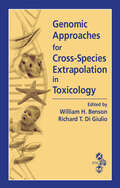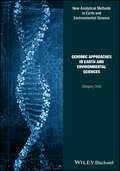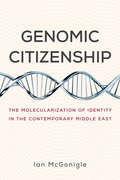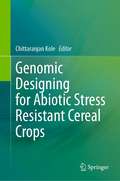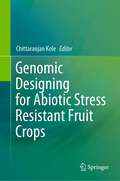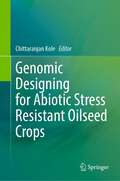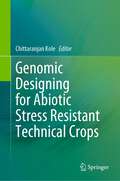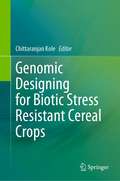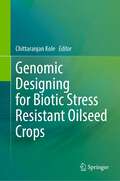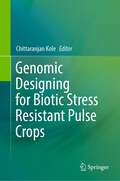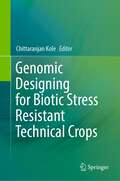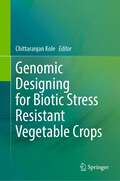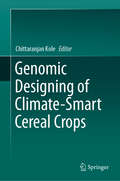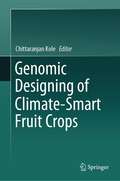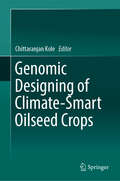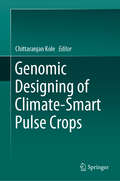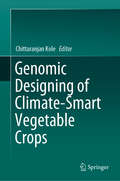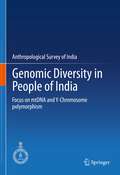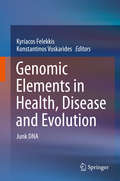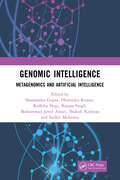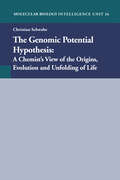- Table View
- List View
Genomic Approaches for Cross-Species Extrapolation in Toxicology
by William H. Benson Richard T. Di GiulioThe latest tools for investigating stress response in organisms, genomic technologies provide great insight into how different organisms respond to environmental conditions. However, their usefulness needs to be tested, verified, and codified. Genomic Approaches for Cross-Species Extrapolation in Toxicology provides a balanced discussion drawn from
Genomic Approaches in Earth and Environmental Sciences (Analytical Methods in Earth and Environmental Science)
by Gregory DickThe first comprehensive synthesis of genomic techniques in earth sciences The past 15 years have witnessed an explosion of DNA sequencing technologies that provide unprecedented insights into biology. Although this technological revolution has been driven by the biomedical sciences, it also offers extraordinary opportunities in the earth and environmental sciences. In particular, the application of "omics" methods (genomics, transcriptomics, proteomics) directly to environmental samples offers exciting new vistas of complex microbial communities and their roles in environmental and geochemical processes. This unique book fills the gap where there exists a lack of resources and infrastructure to educate and train geoscientists about the opportunities, approaches, and analytical methods available in the application of omic technologies to problems in the geosciences. Genomic Approaches in Earth and Environmental Sciences begins by covering the role of microorganisms in earth and environmental processes. It then goes on to discuss how omics approaches provide new windows into geobiological processes. It delves into the DNA sequencing revolution and the impact that genomics has made on the geosciences. The book then discusses the methods used in the field, beginning with an overview of current technologies. After that it offers in-depth coverage of single cell genomics, metagenomics, metatranscriptomics, metaproteomics, and functional approaches, before finishing up with an outlook on the future of the field. The very first synthesis of an important new family of techniques Shows strengths and limitations (both practical and theoretical) of the techniques Deals with both theoretical and laboratory basics Shows use of techniques in a variety of applications, including various aspects of environmental science, geobiology, and evolution Genomic Approaches in Earth and Environmental Sciences is a welcome addition to the library of all earth and environmental scientists and students working within a wide range of subdisciplines.
Genomic Citizenship: The Molecularization of Identity in the Contemporary Middle East
by Ian McGonigleAn anthropological study based on ethnographic work in Israel and Qatar explores the relationship between science, particularly genetics, and national identity.Based on ethnographic work in Israel and Qatar, two small Middle Eastern ethnonations with significant biomedical resources, Genomic Citizenship explores the relationship between science and identity. Ian McGonigle, originally trained as a biochemist, draws on anthropological theory, STS, intellectual history, critical theory, Middle Eastern studies, cultural studies, and critical legal studies. He connects biomedical research on ethnic populations to the political, economic, legal, and historical context of the state; to global trends in genetic medicine; and to the politics of identity in the context of global biomedical research. Genomic Citizenship is more an anthropology of scientific objects than an anthropology of scientists or an ethnography of the laboratory. McGonigle bases his untraditional project on traditional anthropological methods, including participant observation. Some of the most persuasive data in the book are from public records, legal and historical sources, published scientific papers, institutional reports, websites, and brochures. McGonigle discusses biological understandings of Jewishness, especially in relation to the intellectual history of Zionism and Jewish political thought, and considers the possibility of a novel application of genetics in assigning Israeli citizenship. He also describes developments in genetic medicine in Qatar and analyzes the Qatari Biobank in the context of Qatari nationalism and state-building projects. Considering possible consequences of findings on the diverse origins of the Qatari population for tribal identities, he argues that the nation cannot be defined as either a purely natural or biological entity. Rather, it is reified, reinscribed, and refracted through genomic research and discourse.
Genomic Clinical Trials and Predictive Medicine
by Richard M. SimonGenomics is majorly impacting therapeutics development in medicine. This book contains up-to-date information on the use of genomics in the design and analysis of therapeutic clinical trials with a focus on novel approaches that provide a reliable basis for identifying which patients are most likely to benefit from each treatment. It is oriented to both clinical investigators and statisticians. For clinical investigators, it includes background information on clinical trial design and statistical analysis. For statisticians and others who want to go deeper, it covers state-of-the-art adaptive designs and the development and validation of probabilistic classifiers. The author describes the development and validation of prognostic and predictive biomarkers and their integration into clinical trials that establish their clinical utility for informing treatment decisions for future patients.
Genomic Designing for Abiotic Stress Resistant Cereal Crops
by Chittaranjan KoleThis book presents abiotic stresses that cause crop damage in the range of 6-20%. Understanding the interaction of crop plants to the abiotic stresses caused by heat, cold, drought, flooding, submergence, salinity, acidity, etc., is important to develop resistant crop varieties. Knowledge on the advanced genetic and genomic crop improvement strategies including molecular breeding, transgenics, genomic-assisted breeding, and the recently emerging genome editing for developing resistant varieties in cereal crops is imperative for addressing FPNEE (food, health, nutrition, energy, and environment) security. Whole genome sequencing of these crops followed by genotyping-by-sequencing has facilitated precise information about the genes conferring resistance useful for gene discovery, allele mining, and shuttle breeding which in turn opened up the scope for 'designing' crop genomes with resistance to abiotic stresses. The nine chapters each dedicated to a cereal crop in this volume are deliberate on different types of abiotic stresses and their effects on and interaction with crop plants; enumerate on the available genetic diversity with regard to abiotic stress resistance among available cultivars; illuminate on the potential gene pools for utilization in interspecific gene transfer; are brief on the classical genetics of stress resistance and traditional breeding for transferring them to their cultivated counterparts; elucidate on the success stories of genetic engineering for developing abiotic stress-resistant crop varieties; discuss on molecular mapping of genes and QTLs underlying stress resistance and their marker-assisted introgression into elite varieties; enunciate on different emerging genomics-aided techniques including genomic selection, allele mining, gene discovery, and gene pyramiding for developing adaptive crop varieties with higher quantity and quality, and also elaborate some case studies on genome editing focusing on specific genes for generating abiotic stress-resistant crops.
Genomic Designing for Abiotic Stress Resistant Fruit Crops
by Chittaranjan KoleThis book presents deliberations on molecular and genomic mechanisms underlying the interactions of crop plants to the abiotic stresses caused by heat, cold, drought, flooding, submergence, salinity, acidity, etc., important to develop resistant crop varieties. Knowledge on the advanced genetic and genomic crop improvement strategies including molecular breeding, transgenics, genomic-assisted breeding, and the recently emerging genome editing for developing resistant varieties in fruit crops is imperative for addressing FHNEE (food, health, nutrition, energy, and environment) security. Whole genome sequencing in many of these crops followed by genotyping-by-sequencing has provided precise information regarding the genes conferring resistance useful for gene discovery, allele mining, and shuttle breeding which in turn opened up the scope for 'designing' crop genomes with resistance to abiotic stresses. The seven chapters each dedicated to a fruit crop and a fruit crop group in this volume elucidate different types of abiotic stresses and their effects on and interaction with the crops; enumerate the available genetic diversity with regard to abiotic stress resistance among available cultivars; illuminate the potential gene pools for utilization in interspecific gene transfer; present brief on classical genetics of stress resistance and traditional breeding for transferring them to their cultivated counterparts; depict the success stories of genetic engineering for developing abiotic stress-resistant crop varieties; discuss on molecular mapping of genes and QTLs underlying stress resistance and their marker-assisted introgression into elite varieties; enunciate different genomics-aided techniques including genomic selection, allele mining, gene discovery, and gene pyramiding for developing adaptive crop varieties with higher quantity and quality of yields, and also elaborate some case studies on genome editing focusing on specific genes for generating abiotic stress-resistant crops.
Genomic Designing for Abiotic Stress Resistant Oilseed Crops
by Chittaranjan KoleThis book presents deliberations on molecular and genomic mechanisms underlying the interactions of crop plants to the abiotic stresses caused by heat, cold, drought, flooding, submergence, salinity, acidity, etc., important to develop resistant crop varieties. Knowledge on the advanced genetic and genomic crop improvement strategies including molecular breeding, transgenics, genomic-assisted breeding, and the recently emerging genome editing for developing resistant varieties in oilseed crops is imperative for addressing FHNEE (food, health, nutrition, energy, and environment) security. Whole genome sequencing of these crops followed by genotyping-by-sequencing has provided precise information regarding the genes conferring resistance useful for gene discovery, allele mining, and shuttle breeding which in turn opened up the scope for 'designing' crop genomes with resistance to abiotic stresses. The eight chapters each dedicated to a oilseed crop in this volume elucidate on different types of abiotic stresses and their effects on and interaction with the crop; enumerate on the available genetic diversity with regard to abiotic stress resistance among available cultivars; illuminate on the potential gene pools for utilization in interspecific gene transfer; present brief on classical genetics of stress resistance and traditional breeding for transferring them to their cultivated counterparts; depict the success stories of genetic engineering for developing abiotic stress-resistant crop varieties; discuss on molecular mapping of genes and QTLs underlying stress resistance and their marker-assisted introgression into elite varieties; enunciate on different genomics-aided techniques including genomic selection, allele mining, gene discovery, and gene pyramiding for developing adaptive crop varieties with higher quantity and quality of yields, and also elaborate some case studies on genome editing focusing on specific genes for generating abiotic stress-resistant crops.
Genomic Designing for Abiotic Stress Resistant Pulse Crops
by Chittaranjan KoleThis book presents deliberations on molecular and genomic mechanisms underlying the interactions of crop plants to the abiotic stresses caused by heat, cold, drought, flooding, submergence, salinity, acidity, etc., important to develop resistant crop varieties. Knowledge on the advanced genetic and genomic crop improvement strategies including molecular breeding, transgenics, genomic-assisted breeding, and the recently emerging genome editing for developing resistant varieties in pulse crops is imperative for addressing FHNEE (food, health, nutrition, energy, and environment) security. Whole genome sequencing of these crops followed by genotyping-by-sequencing has provided precise information regarding the genes conferring resistance useful for gene discovery, allele mining, and shuttle breeding which in turn opened up the scope for 'designing' crop genomes with resistance to abiotic stresses. The nine chapters each dedicated to a pulse crop in this volume elucidate on different types of abiotic stresses and their effects on and interaction with the crop; enumerate on the available genetic diversity with regard to abiotic stress resistance among available cultivars; illuminate on the potential gene pools for utilization in interspecific gene transfer; present brief on classical genetics of stress resistance and traditional breeding for transferring them to their cultivated counterparts; depict the success stories of genetic engineering for developing abiotic stress-resistant crop varieties; discuss on molecular mapping of genes and QTLs underlying stress resistance and their marker-assisted introgression into elite varieties; enunciate on different genomics-aided techniques including genomic selection, allele mining, gene discovery, and gene pyramiding for developing adaptive crop varieties with higher quantity and quality of yields, and also elaborate some case studies on genome editing focusing on specific genes for generating abiotic stress-resistant crops.
Genomic Designing for Abiotic Stress Resistant Technical Crops
by Chittaranjan KoleThis book presents deliberations on molecular and genomic mechanisms underlying the interactions of crop plants to the abiotic stresses caused by heat, cold, drought, flooding, submergence, salinity, acidity, etc., important to develop resistant crop varieties. Knowledge on the advanced genetic and genomic crop improvement strategies including molecular breeding, transgenics, genomic-assisted breeding, and the recently emerging genome editing for developing resistant varieties in technical crops is imperative for addressing FHNEE (food, health, nutrition, energy, and environment) security. Whole genome sequencing in many of these crops followed by genotyping-by-sequencing has provided precise information regarding the genes conferring resistance useful for gene discovery, allele mining, and shuttle breeding which in turn opened up the scope for 'designing' crop genomes with resistance to abiotic stresses. The ten chapters each dedicated to a technical crop and one chapter devoted to a crop group in this volume elucidate different types of abiotic stresses and their effects on and interaction with the crops; enumerate the available genetic diversity with regard to abiotic stress resistance among available cultivars; illuminate the potential gene pools for utilization in interspecific gene transfer; present brief on classical genetics of stress resistance and traditional breeding for transferring them to their cultivated counterparts; depict the success stories of genetic engineering for developing abiotic stress-resistant crop varieties; discuss on molecular mapping of genes and QTLs underlying stress resistance and their marker-assisted introgression into elite varieties; enunciate different genomics-aided techniques including genomic selection, allele mining, gene discovery, and gene pyramiding for developing adaptive crop varieties with higher quantity and quality of yields, and also elaborate some case studies on genome editing focusing on specific genes for generating abiotic stress-resistant crops.
Genomic Designing for Abiotic Stress Resistant Vegetable Crops
by Chittaranjan KoleThis book presents deliberations on molecular and genomic mechanisms underlying the interactions of crop plants to the abiotic stresses caused by heat, cold, drought, flooding, submergence, salinity, acidity, etc., important to develop resistant crop varieties. Knowledge on the advanced genetic and genomic crop improvement strategies including molecular breeding, transgenics, genomic-assisted breeding, and the recently emerging genome editing for developing resistant varieties in vegetable crops is imperative for addressing FHNEE (food, health, nutrition, energy, and environment) security. Whole genome sequencing of these crops followed by genotyping-by-sequencing has provided precise information regarding the genes conferring resistance useful for gene discovery, allele mining, and shuttle breeding which in turn opened up the scope for 'designing' crop genomes with resistance to abiotic stresses.The nine chapters each dedicated to a vegetable crop or crop group in this volume elucidate on different types of abiotic stresses and their effects on and interaction with the crop; enumerate on the available genetic diversity with regard to abiotic stress resistance among available cultivars; illuminate on the potential gene pools for utilization in interspecific gene transfer; present brief on classical genetics of stress resistance and traditional breeding for transferring them to their cultivated counterparts; depict the success stories of genetic engineering for developing abiotic stress-resistant crop varieties; discuss on molecular mapping of genes and QTLs underlying stress resistance and their marker-assisted introgression into elite varieties; enunciate on different genomics-aided techniques including genomic selection, allele mining, gene discovery, and gene pyramiding for developing adaptive crop varieties with higher quantity and quality of yields, and also elaborate some case studies on genome editing focusing on specific genes for generating abiotic stress-resistant crops
Genomic Designing for Biotic Stress Resistant Cereal Crops
by Chittaranjan KoleThis book presents deliberations on molecular and genomic mechanisms underlying the interactions of crop plants to the biotic stresses caused by different diseases and pests that are important to develop resistant crop varieties. Knowledge on the advanced genetic and genomic crop improvement strategies including molecular breeding, transgenics, genomic-assisted breeding, and the recently emerging genome editing for developing resistant varieties in cereal crops is imperative for addressing FHNEE (food, health, nutrition, energy, and environment) security. Whole genome sequencing of these crops followed by genotyping-by-sequencing has provided precise information regarding the genes conferring resistance useful for gene discovery, allele mining, and shuttle breeding which in turn opened up the scope for 'designing' crop genomes with resistance to biotic stresses. The eight chapters each dedicated to a cereal crop in this volume elucidate on different types of biotic stresses and their effects on and interaction with the crop; enumerate on the available genetic diversity with regard to biotic stress resistance among available cultivars; illuminate on the potential gene pools for utilization in interspecific gene transfer; present brief on classical genetics of stress resistance and traditional breeding for transferring them to their cultivated counterparts; depict the success stories of genetic engineering for developing biotic stress-resistant crop varieties; discuss on molecular mapping of genes and QTLs underlying stress resistance and their marker-assisted introgression into elite varieties; enunciate on different genomics-aided techniques including genomic selection, allele mining, gene discovery, and gene pyramiding for developing adaptive crop varieties with higher quantity and quality of yields, and also elaborate some case studies on genome editing focusing on specific genes for generating biotic stress-resistant crops.
Genomic Designing for Biotic Stress Resistant Fruit Crops
by Chittaranjan KoleThis book presents deliberations on the molecular and genomic mechanisms underlying the interactions of crop plants with the biotic stresses caused by insects, bacteria, fungi, viruses, and oomycetes, etc. important to develop resistant crop varieties. Knowledge on the advanced genetic and genomic crop improvement strategies including molecular breeding, transgenics, genomic-assisted breeding and the recently emerging genome editing for developing resistant varieties in fruit crops is imperative for addressing FPNEE (food, health, nutrition. energy and environment) security. Whole genome sequencing of these crops followed by genotyping-by-sequencing have facilitated precise information about the genes conferring resistance useful for gene discovery, allele mining and shuttle breeding which in turn opened up the scope for 'designing' crop genomes with resistance to biotic stresses. The nine chapters, each dedicated to a fruit crop in this volume, deliberate on different types of biotic stress agents and their effects on and interaction with the crop plants; enumerate the available genetic diversity with regard to biotic stress resistance among available cultivars; illuminate on the potential gene pools for utilization in interspecific gene transfer; present brief on the classical genetics of stress resistance and traditional breeding for biotic stress resistance; depict the success stories of genetic engineering for developing biotic stress resistant varieties; discuss on molecular mapping of genes and QTLs underlying biotic stress resistance and their marker-assisted introgression into elite varieties; enunciate different emerging genomics-aided techniques including genomic selection, allele mining, gene discovery and gene pyramiding for developing resistant crop varieties with higher quantity and quality of yield; and also elaborate some case studies on genome editing focusing on specific genes for generating disease and insect resistant crops.
Genomic Designing for Biotic Stress Resistant Oilseed Crops
by Chittaranjan KoleBiotic stresses cause yield loss of 31-42% in crops in addition to 6-20% during post-harvest stage. Understanding interaction of crop plants to the biotic stresses caused by insects, bacteria, fungi, viruses, and oomycetes, etc. is important to develop resistant crop varieties. Knowledge on the advanced genetic and genomic crop improvement strategies including molecular breeding, transgenics, genomic-assisted breeding and the recently emerging genome editing for developing resistant varieties in oilseed crops is imperative for addressing FPNEE (food, health, nutrition. energy and environment) security. Whole genome sequencing of these crops followed by genotyping-by-sequencing have facilitated precise information about the genes conferring resistance useful for gene discovery, allele mining and shuttle breeding which in turn opened up the scope for 'designing' crop genomes with resistance to biotic stresses. The eight chapters each dedicated to an oilseed crop in this volume elucidate on different types of biotic stress agents and their effects on and interaction with the crop plants; enumerate on the available genetic diversity with regard to biotic stress resistance among available cultivars; illuminate on the potential gene pools for utilization in interspecific gene transfer; present brief on the classical genetics of stress resistance and traditional breeding for transferring them to their cultivated counterparts; depict the success stories of genetic engineering for developing biotic stress resistant varieties; discuss on molecular mapping of genes and QTLs underlying biotic stress resistance and their marker-assisted introgression into elite varieties; enunciate on different emerging genomics-aided techniques including genomic selection, allele mining, gene discovery and gene pyramiding for developing resistant crop varieties with higher quantity and quality of yields; and also elaborate some case studies on genome editing focusing on specific genes for generating disease and insect resistant crops.
Genomic Designing for Biotic Stress Resistant Pulse Crops
by Chittaranjan KoleBiotic stresses cause yield loss of 31-42% in crops in addition to 6-20% during post-harvest stage. Understanding interaction of crop plants to the biotic stresses caused by insects, bacteria, fungi, viruses, and oomycetes, etc. is important to develop resistant crop varieties. Knowledge on the advanced genetic and genomic crop improvement strategies including molecular breeding, transgenics, genomic-assisted breeding and the recently emerging genome editing for developing resistant varieties in pulse crops is imperative for addressing FPNEE (food, health, nutrition. energy and environment) security. Whole genome sequencing of these crops followed by genotyping-by-sequencing have facilitated precise information about the genes conferring resistance useful for gene discovery, allele mining and shuttle breeding which in turn opened up the scope for 'designing' crop genomes with resistance to biotic stresses.The nine chapters each dedicated to a pulse crop in this volume elucidate on different types of biotic stress agents and their effects on and interaction with the crop plants; enumerate on the available genetic diversity with regard to biotic stress resistance among available cultivars; illuminate on the potential gene pools for utilization in interspecific gene transfer; present brief on the classical genetics of stress resistance and traditional breeding for transferring them to their cultivated counterparts; depict the success stories of genetic engineering for developing biotic stress resistant varieties; discuss on molecular mapping of genes and QTLs underlying biotic stress resistance and their marker-assisted introgression into elite varieties; enunciate on different emerging genomics-aided techniques including genomic selection, allele mining, gene discovery and gene pyramiding for developing resistant crop varieties with higher quantity and quality of yields; and also elaborate some case studies on genome editing focusing on specific genes for generating disease and insect resistant crops.
Genomic Designing for Biotic Stress Resistant Technical Crops
by Chittaranjan KoleBiotic stresses cause yield loss of 31-42% in crops in addition to 6-20% during post-harvest stage. Understanding interaction of crop plants to the biotic stresses caused by insects, bacteria, fungi, viruses, and oomycetes, etc. is important to develop resistant crop varieties. Knowledge on the advanced genetic and genomic crop improvement strategies including molecular breeding, transgenics, genomic-assisted breeding and the recently emerging genome editing for developing resistant varieties in technical crops is imperative for addressing FHEE (food, health, energy and environment) security. Whole genome sequencing of these crops followed by genotyping-by-sequencing have facilitated precise information about the genes conferring resistance useful for gene discovery, allele mining and shuttle breeding which in turn opened up the scope for 'designing' crop genomes with resistance to biotic stresses. The 15 chapters dedicated to 13 technical crops and 2 technical crop groups in this volume will deliberate on different types of biotic stress agents and their effects on and interaction with crop plants; will enumerate on the available genetic diversity with regard to biotic stress resistance among available cultivars; illuminate on the potential gene pools for utilization in interspecific gene transfer; will brief on the classical genetics of stress resistance and traditional breeding for transferring them to their cultivated counterparts; will enunciate the success stories of genetic engineering for developing biotic stress resistant varieties; will discuss on molecular mapping of genes and QTLs underlying biotic stress resistance and their marker-assisted introgression into elite varieties; will enunciate on different emerging genomics-aided techniques including genomic selection, allele mining, gene discovery and gene pyramiding for developing resistant crop varieties with higher quantity and quality; and will also elaborate some case studies on genome editing focusing on specific genes for generating disease and insect resistant crops.
Genomic Designing for Biotic Stress Resistant Vegetable Crops
by Chittaranjan KoleBiotic stresses cause yield loss of 31-42% in crops in addition to 6-20% during post-harvest stage. Understanding interaction of crop plants to the biotic stresses caused by insects, bacteria, fungi, viruses, and oomycetes, etc. is important to develop resistant crop varieties. Knowledge on the advanced genetic and genomic crop improvement strategies including molecular breeding, transgenics, genomics-assisted breeding and the recently emerging genome editing for developing resistant varieties in vegetable crops is imperative for addressing FPNEE (food, health, nutrition. energy and environment) security. Whole genome sequencing of these crops followed by genotyping-by-sequencing have facilitated precise information about the genes conferring resistance useful for gene discovery, allele mining and shuttle breeding which in turn opened up the scope for 'designing' crop genomes with resistance to biotic stresses. The nine chapters each dedicated to a vegetable crop or crop-group in this volume will deliberate on different types of biotic stress agents and their effects on and interaction with crop plants; will enumerate on the available genetic diversity with regard to biotic stress resistance among available cultivars; illuminate on the potential gene pools for utilization in interspecific gene transfer; will brief on the classical genetics of stress resistance and traditional breeding for transferring them to their cultivated counterparts; will enunciate the success stories of genetic engineering for developing biotic stress resistant varieties; will discuss on molecular mapping of genes and QTLs underlying biotic stress resistance and their marker-assisted introgression into elite varieties; will enunciate on different emerging genomics-aided techniques including genomic selection, allele mining, gene discovery and gene pyramiding for developing resistant crop varieties with higher quantity and better quality; and will also elaborate some case studies on genome editing focusing on specific genes for generating disease and insect resistant crops.
Genomic Designing of Climate-Smart Cereal Crops
by Chittaranjan KoleThis book highlights modern methods and strategies to improve cereal crops in the era of climate change, presenting the latest advances in plant molecular mapping and genome sequencing. Spectacular achievements in the fields of molecular breeding, transgenics and genomics in the last three decades have facilitated revolutionary changes in cereal- crop-improvement strategies and techniques. Since the genome sequencing of rice in 2002, the genomes of over eight cereal crops have been sequenced and more are to follow. This has made it possible to decipher the exact nucleotide sequence and chromosomal positions of agroeconomic genes. Most importantly, comparative genomics and genotyping-by-sequencing have opened up new vistas for exploring available biodiversity, particularly of wild crop relatives, for identifying useful donor genes.
Genomic Designing of Climate-Smart Fruit Crops
by Chittaranjan KoleThis edited book provides a comprehensive overview of modern strategies in fruit crop breeding in the era of climate change and global warming. It demonstrates how advances in plant molecular and genomics-assisted breeding can be utilized to produce improved fruit crops with climate-smart traits. Agriculture is facing a number of challenges in the 21st century, as it has to address food, nutritional, energy and environmental security. Future fruit varieties must be adaptive to the varying scenarios of climate change, produce higher yields of high-quality food, feed, and fuel and have multiple uses. To achieve these goals, it is imperative to employ modern tools of molecular breeding, genetic engineering and genomics for ‘precise’ plant breeding to produce ‘designed’ fruit crop varieties.This book is of interest to scientists working in the fields of plant genetics, genomics, breeding, biotechnology, and in the disciplines of agronomy and horticulture.
Genomic Designing of Climate-Smart Oilseed Crops
by Chittaranjan KoleThis book highlights modern strategies and methods to improve oilseed crops in the era of climate change, presenting the latest advances in plant molecular breeding and genomics-driven breeding. Spectacular achievements in the fields of molecular breeding, transgenics and genomics in the last three decades have facilitated revolutionary changes in oilseed- crop-improvement strategies and techniques. Since the genome sequencing of rice, as the first crop plant, in 2002, the genomes of about one dozen oilseed crops have been sequenced and more are to follow. This has made it possible to decipher the exact nucleotide sequence and chromosomal positions of agroeconomic genes. Most importantly, comparative genomics and genotyping-by-sequencing have opened up new vistas for exploring available biodiversity, particularly of wild crop relatives, for identifying useful donor genes.
Genomic Designing of Climate-Smart Pulse Crops
by Chittaranjan KoleThis book describes the concepts, strategies and techniques for pulse-crop improvement in the era of climate change, highlighting the latest advances in plant molecular mapping and genome sequencing. Genetic mapping of genes and QTLs has broadened the scope of marker-assisted breeding and map-based cloning in almost all major pulse crops. Genetic transformation, particularly using alien genes conferring resistance to herbicide, insects and diseases has facilitated the development of a huge number of genetically modified varieties of the major pulse crops. Since the genome sequencing of rice in 2002, genomes of over 7 pulse crops have been sequenced. This has resulted in the possibility of deciphering the exact nucleotide sequence and chromosomal positions of agroeconomic genes. Most importantly, comparative genomics and genotyping-by-sequencing has opened up a new vista for exploring wild crop relatives for identification of useful donor genes.
Genomic Designing of Climate-Smart Vegetable Crops
by Chittaranjan KoleThis book reviews modern strategies in the breeding of vegetables in the era of global warming. Agriculture is facing numerous challenges in the 21st century, as it has to address food, nutritional, energy and environmental security. Future vegetable varieties must be adaptive to the varying scenarios of climate change, produce higher yields of high- quality food and feed and have multiple uses. To achieve these goals, it is imperative to employ modern tools of molecular breeding, genetic engineering and genomics for ‘precise’ plant breeding to produce ‘designed’ vegetable varieties adaptive to climate change.This book is of interest to scientists working in the fields of plant genetics, genomics, breeding, biotechnology, and in the disciplines of agronomy and horticulture.
Genomic Diversity in People of India: Focus on mtDNA and Y-Chromosome polymorphism
by Anthropological Survey Of IndiaThis book is the output of Anthropological Survey of India's National Project "DNA Polymorphism of Contemporary Indian Population" conducted during 2000 to 2018. The book compiles the independent and collaborative work of 49 scientific personnel. Genomics facilitate the study of genetic constitution and diversity at individual and population levels. Genomic diversity explains susceptibility, predisposition and prolongation of diseases; personalized medicine and longevity; prehistoric demographic events, such as population bottleneck, expansion, admixture and natural selection. This book highlights the heterogeneous, genetically diverse population of India. It shows how the central geographic location of India, played a crucial role in historic and pre-historic human migrations, and in peopling different continents of the world. The book describes the massive task undertaken by AnSI to unearth genomic diversity of India populations, with the use of Uni-parental DNA markers mtDNA (mitochondrial DNA) and Y –chromosome in 75 communities. The book talks about the 61 maternal and 35 paternal lineages identified through these studies. It brings forth interesting, hitherto unknown findings such as shared mutations between certain communities. This volume is a milestone in scientific research to understand biological diversity of Indian people at genomic level. It addresses the basic priority to identify different genes underlying various inborn genetic defects and diseases specific to Indian populations. This would be highly interesting to population geneticists, historians, as well as anthropologists.
Genomic Elements in Health, Disease and Evolution
by Kyriacos Felekkis Konstantinos VoskaridesOver 98% of the human genome contains non-coding DNA sequences. For many years molecular biologists referred to this component of the genome as the "junk" DNA since it does not code for any "useful" protein product. Over the last years this notion changed significantly as scientists discovered that a large part of this DNA contains various genomic elements that have important roles in cell physiology. Genomic elements such as non-coding RNAs, transposons, splicing RNAs, DNA repeats and others were shown to play a significant role in regulating gene expression. In addition, all these elements were implicated to contribute in the pathogenesis or progression of various human diseases. In this book, the editor will attempt to describe all these genomic elements that constitute the junk DNA of the genome. For every genomic element, the physiologic role in the organism, its role in evolution and any possible involvement in human diseases will be discussed. Additionally, interaction between these elements in normal or pathologic condition will be discussed. Since a large amount of new knowledge is generated daily in regards to these genomic elements, this book will attempt to combine all the information in a single publication that can serve as a reference for future studies. The first part will discuss RNA elements such as microRNAs, long non-coding RNAs, piRNAs and splicing RNAs. The second part of the book will deal with transposons, retrotransposons and DNA transposons. Finally the third part of the book will discuss DNA elements that include DNA repeats, conserved non-coding sequences, distal genomic elements, introns, pseudogenes, CpG islands and telomeres. For miRNAs and CNVs a separate chapter will be dedicated to their role in human diseases since an extensive amount of information exists about these two elements.
Genomic Intelligence: Metagenomics and Artificial Intelligence
by Sheetanshu Gupta Dhirendra Kumar Radhika Negi Ranjan Singh Mohammad Javed Ansari Shakuli Kashyap Sudhir MehrotraThe field of metagenomics has revolutionized our comprehension of microbial diversity and function across various habitats, from the human body to terrestrial and aquatic environments. Simultaneously, advancements in AI have empowered researchers to analyze vast troves of genomic data with unprecedented speed and precision, facilitating new insights into the complex interplay between microorganisms and their surroundings.The subject matter in this book provides an overview of metagenomics and discusses the combination of metagenomics and AI and its significant consequences for advancements in science. The chapters examine the approaches, difficulties, and revolutionary uses of AI in metagenomics and provide insight into the convergence of genomics, metagenomics, and AI’s potential to revolutionize diverse fields from healthcare to environmental.Print edition not for sale in South Asia (India, Sri Lanka, Nepal, Bangladesh, Pakistan or Bhutan)
The Genomic Potential Hypothesis: A Chemist's View of the Origins, Evolution and Unfolding of Life
by Christian SchwabeThe Genomic Potential Hypothesis is a biochemist's view of the origin, evolution, and development of life. Large numbers are second nature to a biochemist and though he rarely ever thinks of it explicitly, the concept of mass action is a part of the definition of chemistry. The origin of life, from that perspective, will turn into an event that occurs on the molar scale in units of 1023 and is driven not by needs of biological systems but by mass action, energetics, structure, and kinetics. This approach to evolution entails the total denial of constructive accidents. Mutations are a reality and while most of them are of no consequence or detrimental, one cannot deny that on occasion a beneficial mutation might occur. However, to invoke strings of beneficial mutations that suffice to reshape one animal into the shape of another is not merely unreasonable, it is not science. Evolution will be restricted to the reorganization of nuclear material in line with equilibrium constants and kinetic parameters that govern the quasi two-dimensional chemistry of nucleic acids. The actual evolution occurs at the cellular level and is noted only by the results appearing in the fossil record as small versions of the final form.
